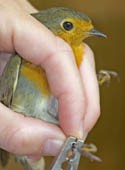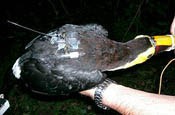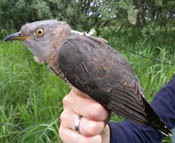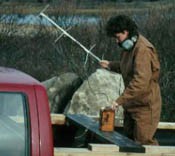Using Animal Tracking Data from Movebank for Science Projects
What is Movebank?
Movebank, Tracking Data Map, is an archive of animal movement data collected by scientists in the course of their research. Many of these scientists have agreed to share their real data with you, a user of the Science Buddies website, to analyze and use in your own science projects.
How do wildlife biologists track animals?
In order to understand more about animal behavior and habitats, wildlife biologists track animals. They do this by attaching tracking devices, often called tags to individual animals. There are several different types of tags, which range in price, type of data they can record, size, and geographic range. Table 1, below, describes four of the most commonly used types of tags.
| Type of Tag | Description | Advantages | Disadvantages |
Band or ring 
A small band is being carefully closed around this European robin's leg. (Photo courtesy of Wolfgang Fiedler©.) |
A physical tag, with no electronic components, that is attached to the animal. Each individual has a unique number code on its band. |
These tags are inexpensive, and can be attached by trained volunteers, making it easy to tag many individual birds. These tags can be lightweight enough for even the smallest animals, like hummingbirds. |
Collecting information requires someone to physically make an observation that a banded animal is at a specific location and report that data back to the banding center indicated on the tag. |
Very High Frequency (VHF) Radio Transmitter Wildlife biologist using a receiver and antenna to track deer with radio transmitter collars. |
An electronic tag that emits very high radio frequencies. |
These tags are typically less expensive than GPS or Argos, but are more expensive than banding. They have a long battery life and can be used for many years. These tags, which can be very lightweight, can be used on small animals. |
Collecting information requires a person, either on foot or by low-flying airplane, to find and track the signal using a receiver and directional antennae. For this reason, they do not work well to get a full view of a geographically large migration. |
GPS 
A GPS tag attached to the back of a toucan. (Photo courtesy of Martin Wikelski©.) |
An electronic tag where the tag itself calculates, using GPS technology, the exact location of the animal at specific time intervals. |
These tags convey the most precise time and location data and do not rely on a person to make a physical observation. |
Tags are expensive and cannot be attached by volunteers; this limits the number of individual animals tagged in a study. Compared to Argos Doppler tags, they might have shorter working life spans. |
Argos Doppler 
A 5-gram Argos Doppler tag on a European cuckoo. (Photo courtesy of Roine Strandberg©.) |
An electronic tag that transmits signals to the Argos satellite at specific time intervals. The satellite then calculates the geographic location based on the tag signal. |
These tags convey time and location data and do not rely on a person making a physical observation. These are the smallest electronic tags that are currently available and can be used for smaller animals. |
Tags are expensive and cannot be attached by volunteers; this limits the number of individual animals tagged in a study. The geographic location data is less precise than with a GPS tag. |
When designing a study, the wildlife biologists decide which tagging method will best enable them to answer the specific question they're studying. All of the tags require the scientists to capture the animals and attach the tag. This video shows how biologists attach tags to birds. More images of scientist capturing and attaching tracking tags can be found at Migration Photos on flickr.
What kinds of science projects can be done using Movebank data?
Scientists have shared a wide variety of animal movement data from Movebank with Science Buddies, and new data sets are being added as they become available. This means that the types of questions that can be asked are limitless.
Here are some examples of the types of questions you can ask using the available data:
- How similar are the migratory paths of different individuals within a species?
- How large is the home range of a particular animal?
- Where does a specific species, such as Indiana bats (Myotis sodalist), go to breed after they wake up from hibernation?
- How do roads affect the movement patterns of land animals?
- How does weather affect an animal's movement patterns?
- What are the speeds and geographic ranges of different types of animals during migration?
Furthermore, Science Buddies staff scientists, in conjunction with researchers at the 2010 Migrate Meeting, have developed two Project Ideas that take advantage of specific data sets:
Give credit where credit is due.
For every Movebank data set you use in your science fair project, you must give credit to the scientist(s) who created the data set. When you download data from Movebank, a pop-up box appears asking you to confirm that you will follow the terms of agreement. This box contains all the data you need to credit the appropriate people. If the Citation field is filled in, use this information in your Bibliography. Otherwise, use the study name and the names listed in the Acknowledgments. Figure 2, above, shows an example of one of these pop-up boxes. The appropriate bibliographic entry for this example would be:
- Kays, R.W., and Gittleman, J.L. (2001). The Social Organization of the Kinkajou Potos flavus (Procynonidae). Journal of Zoology 253: 491-504. Retrieved [insert date you downloaded data set], from http://www.movebank.org





